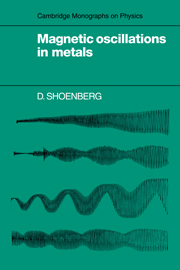Book contents
- Frontmatter
- Contents
- Preface
- List of symbols and abbreviations
- 1 Historical introduction
- 2 Theory
- 3 Observation of the de Haas–van Alphen effect
- 4 Other oscillatory effects
- 5 Fermi surfaces and cyclotron masses
- 6 Magnetic interaction
- 7 Magnetic breakdown
- 8 The Dingle temperature
- 9 Phase and spin-splitting
- Appendices
- Bibliography and author index
- Notes added in proof
- Subject index
5 - Fermi surfaces and cyclotron masses
Published online by Cambridge University Press: 07 October 2011
- Frontmatter
- Contents
- Preface
- List of symbols and abbreviations
- 1 Historical introduction
- 2 Theory
- 3 Observation of the de Haas–van Alphen effect
- 4 Other oscillatory effects
- 5 Fermi surfaces and cyclotron masses
- 6 Magnetic interaction
- 7 Magnetic breakdown
- 8 The Dingle temperature
- 9 Phase and spin-splitting
- Appendices
- Bibliography and author index
- Notes added in proof
- Subject index
Summary
Introduction
During the last 25 years de Haas–van Alphen studies have led to a spectacular advance in our knowledge of the Fermi surface of metals and (to a lesser extent) of the differential properties of the surfaces of constant energy in the vicinity of the FS. This progress has been made possible partly by parallel developments in the theoretical understanding of band structures, but perhaps more significantly by advances in technology. These advances, in the production of high magnetic fields and low temperatures, in electronic techniques and data processing and in the growing of purer and more perfect single crystals, are still continuing and hopefully will continue to be exploited to extend our knowledge still further.
By far the greatest effort has gone into measurements of dHvA frequencies F with a view to the determination of the FS of metals through the Onsager relation and by now the FS of nearly all the metallic elements and of many intermetallic compounds have in fact been determined. The level of determination achieved however, varies both in the degree of certainty with which the qualitative nature of the surface has been established and in the precision of the quantitative specification of the surface. At best, the qualitative nature of the surface (i.e. the number and shapes of the separate sheets) is reliably known and the dimensions of the various sheets determined with a precision of order 1 in 10.
- Type
- Chapter
- Information
- Magnetic Oscillations in Metals , pp. 178 - 253Publisher: Cambridge University PressPrint publication year: 1984



